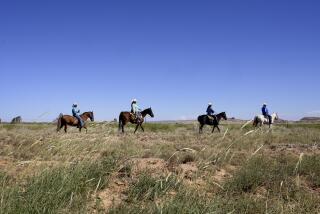In Guadalupe, one of the state’s smallest towns, residents push back against persistent poverty
GUADALUPE, Ariz. Just 300 feet separate a meticulously manicured resort and golf course from the tiny town of Guadalupe, where 31 percent of its mostly Latino and Yaqui Indian population live in poverty and only about 54 percent of its children graduate from high school.
According to the most recent U.S. Census Bureau numbers, Guadalupe is one of the poorest communities in Arizona. Its lack of thriving local businesses and its dilapidated houses and buildings illustrate the woes of the state’s Latino population in places where jobs are scarce and students struggle to stay in school.
“Poverty is so vicious that it doesn’t allow people sometimes to get out from under its thumb,” said Joseph Garcia, director of the Latino Public Policy Center at Arizona State University’s Morrison Institute. “And people get so worn down, they don’t see the possibilities of how to escape poverty.”
The National Center for Children in Poverty reports that about 400,000 children in Arizona or 26 percent are poor.
“Arizona will drop to a second-tier state and it could be on a permanent basis if we don’t correct it,” Garcia said. “Education is the great equalizer when you come out of poverty.”
Guadalupe incorporated as a town in 1975, but has been home to the Yaqui Indians in Arizona for more than a century.
As Arizona cuts back on its assistance to needy families, the residents of Guadalupe say they are pushing forward on their own. One of them, Marina Gonzales, started an after-school program because parents wanted more tutoring for their children.
“Over half of the kids in Guadalupe will not graduate high school and our goal is to make sure every kid in our program graduates,” said Gonzales, a teacher in the Guadalupe learning lab. “Education is a big problem, a lot of our kids are below grade level and the reason for that is sometimes the parents don’t have an education or the families are broken up.”
At Frank Elementary, the town’s only public school, nearly 90 percent of the students qualify for free or reduced lunch and their first language is Spanish.
“If they don’t close the gap early, by the time they get to high school, they are very frustrated and they tend to drop out,” said Bernadette Kadel, director of instructional experience in the Tempe Elementary School District.”
Less than 6 percent of Guadalupe’s residents have a bachelor’s degree or better.
“They don’t see themselves going to college. Perhaps they aren’t college-ready, either. The answer isn’t always just putting people in college and they are going to succeed,” said Garcia.
About 18 percent of Arizonans live in poverty, census data shows. Guadalupe is one of several cities and towns where poverty percentages are much higher. In Bisbee, for example, 26 percent live in poverty, in Douglas, 31 percent and in Tuba City, 29 percent.
“If you live in a community where everyone is doing manual labor and your neighbors are doing that, your uncles, your parents ... that’s your environment,” Garcia said. That’s how you see things and that’s what you end up doing.”
David Verdugo, 19, has lived with his grandmother since his mother went to addiction treatment. He said he didn’t even think about going to college because his grandmother needs him at home.
“She’s everything,” he said. “She’s my inspiration,” adding that he never understood the extent of their poverty until he was older.
“I thought it was just normal until I started growing up and realizing, ‘Oh, we’re poor,’” Verdugo said.
He and other teens are part of a local youth program that encourages them to avoid drugs and alcohol, stay in school and seek a better future.
“You gotta see beyond the dilapidated houses ... beyond the little stores. Look at our heart,” said Anita Soto, who volunteers at the local youth program.
She says the town stays connected through their culture and faith.
“Guadalupe is blessed and the definition of blessed to prosper ... we have been empowered to prosper,” Soto said.
Verdugo still wants to go to college and play football.
“You guys seem so happy,” he said. “I want to be like that, experience that kind of happy.”
Armando Tavizon also grew up Guadalupe and is in his first year at South Mountain Community College.
“I am finally getting out of here,” he said. “If you really had a mind set and you really wanted to get out of where you’re at, I mean, you could do it. All you have to do is sit in the middle of the class and pay attention. It’s not that hard.”
(c)2015 Cronkite News
Distributed by Tribune Content Agency, LLC.
More to Read
Sign up for Essential California
The most important California stories and recommendations in your inbox every morning.
You may occasionally receive promotional content from the Los Angeles Times.










